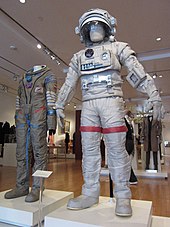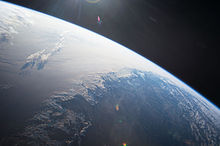Gravity (2013 film)
It stars Sandra Bullock and George Clooney as American astronauts who attempt to return to Earth after the destruction of their Space Shuttle in orbit.
Kowalski, using a Manned Maneuvering Unit (MMU), rescues Stone and they return to the Explorer, discovering that the Shuttle has suffered catastrophic damage and the rest of the crew are dead.
As they approach the station, they see that the ISS's crew has evacuated using one of its two Soyuz spacecraft, the remaining craft exhibiting damage and unable to return to Earth.
Kowalski suggests using it to travel to the nearby Tiangong space station,[N 1] 100 km (60 mi) away, in order to board the Shenzhou spacecraft to return to Earth.
As she maneuvers the Soyuz away from the ISS, the tangled parachute tethers snag, preventing the spacecraft from leaving; Stone performs a spacewalk to cut the cables, succeeding just as the debris field returns, destroying the station.
After an attempt at radio communication with an Inuit on Earth, Stone resigns herself to her fate and shuts off the cabin's oxygen supply to commit suicide.
As she begins to lose consciousness, she experiences a hallucination of Kowalski telling her to rig the Soyuz's soft landing rockets to propel the capsule towards Tiangong.
[30][31][32][33] Cuarón uses the Stone character to illustrate clarity of mind, persistence, training, and improvisation in the face of isolation and the consequences of a relentless Murphy's law.
[28] The film incorporates spiritual or existential themes, in the facts of Stone's daughter's accidental and meaningless death, and in the necessity of summoning the will to survive in the face of overwhelming odds, without future certainties, and with the impossibility of rescue from personal dissolution without finding this willpower.
[21][30][37][38] The film opens with the exploration of space—the vanguard of human civilization—and ends with an allegory of the dawn of mankind when Ryan Stone fights her way out of the water after the crash-landing, passing a frog, grabs the soil, and slowly regains her capacity to stand upright and walk.
[38] Earlier imagery depicting the formation of life includes a scene after Stone enters the space station airlock, and rests in an embryonic position, surrounded by a rope strongly resembling an umbilical cord.
The film also suggests themes of humanity's ubiquitous strategy of existential resilience; that, across cultures, individuals must postulate meaning, beyond material existence, wherever none can be perceived.
[44] When co-chairmen Marc Shmuger and David Linde were ousted from Universal in 2009, Cuarón asked for the project to be released, and then Warner Bros Pictures chief Jeff Robinov stepped in.
[53] Scheduling conflicts with the television series Gossip Girl in Manhattan and the film The Town in Boston prevented actress Blake Lively from getting the part.
[53] In September 2010, Cuarón received approval from Warner Bros. to offer the role without a screen test to Natalie Portman, who was praised for her performance in Black Swan (2010) at that time.
Other stars considered to some degree included Naomi Watts, Carey Mulligan, Scarlett Johansson, Sienna Miller, Abbie Cornish, Rebecca Hall, and Olivia Wilde.
"[66] Cuarón said his biggest challenge was to make the set feel as inviting and non-claustrophobic as possible, including having a large celebration each day when Bullock arrived.
Cuarón asked Lubezki to start the film with a brightly lit Earth, adding shadows and dusk as the threat grows stronger.
[85] Gravity emerged as one of the most successful sci-fi films of all time, and the biggest box office hit of both Sandra Bullock and George Clooney's careers.
[92] Gravity topped the box office and broke the record held by Paranormal Activity 3 (2011) as the highest-earning October and autumn openings, grossing $55.8 million from 3,575 theaters.
The website's critical consensus states: "Alfonso Cuarón's Gravity is an eerie, tense sci-fi thriller that's masterfully directed and visually stunning.
[30] Justin Chang, writing for Variety, said that the film "restores a sense of wonder, terror and possibility to the big screen that should inspire awe among critics and audiences worldwide".
[110] Richard Corliss of Time praised Cuarón for playing "daringly and dexterously with point-of-view: at one moment you're inside Ryan's helmet as she surveys the bleak silence, then in a subtle shift you're outside to gauge her reaction.
The 3-D effects, added in post-production, provide their own extraterrestrial startle: a hailstorm of debris hurtles at you, as do a space traveler's thoughts at the realization of being truly alone in the universe.
"[106] Peter Bradshaw of The Guardian gave the film five out of five stars, writing "a brilliant and inspired movie-cyclorama ... a glorious imaginary creation that engulfs you utterly.
Gravity received a leading 10 nominations at the 86th Academy Awards (with American Hustle), including Best Picture, Best Actress for Bullock, and Best Production Design.
Astronaut Buzz Aldrin called the visual effects "remarkable" and he hoped that the film would stimulate the public to find an interest in space again, after decades of diminishing investments into advancements in the field:[143] I was so extravagantly impressed by the portrayal of the reality of zero gravity.
"[145] In contrast, Vanessa Reich-Shackelford from Westcoast Women in Engineering, Science and Technology while considering the character of Dr. Ryan Stone wrote: "I came to realize that writers Alfonso (also director) and Jonás Cuarón had created one of the most positive representation of a woman in STEM on screen so far.
"[146] Astrophysicist Neil deGrasse Tyson, astronomer and skeptic Phil Plait, and veteran NASA astronaut and spacewalker Scott E. Parazynski have offered comments about some of the most "glaring" inaccuracies.
In reality, the debris field created by a destroyed communications satellite would likely not impact the Hubble Space Telescope which is where the shuttle Explorer is at the beginning of the film.





